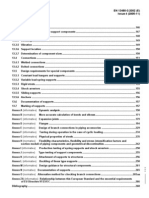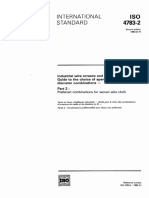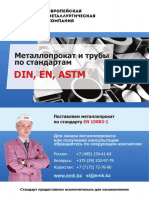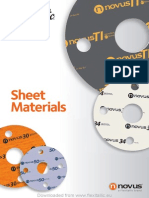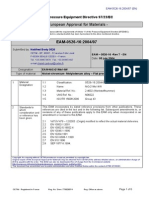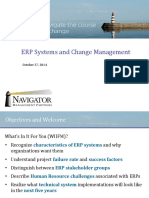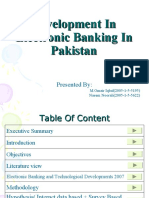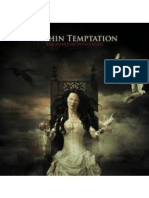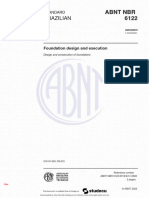PED 2014 68 Eu Classification and Categories
PED 2014 68 Eu Classification and Categories
Uploaded by
ankit7588Copyright:
Available Formats
PED 2014 68 Eu Classification and Categories
PED 2014 68 Eu Classification and Categories
Uploaded by
ankit7588Original Title
Copyright
Available Formats
Share this document
Did you find this document useful?
Is this content inappropriate?
Copyright:
Available Formats
PED 2014 68 Eu Classification and Categories
PED 2014 68 Eu Classification and Categories
Uploaded by
ankit7588Copyright:
Available Formats
B.
CLASSIFICATION AND CATEGORIES
Guideline B-01
Pressure Equipment Directive PED 2014/68/EU
Commission's Working Group "Pressure"
Guideline related to: Article 4 paragraph 1 (d); Annex II point 3
Question There is a contradiction between the requirements in article 4 paragraph
1 (d) and those in Annex II point 3.
Can pressure accessories be classified as “article 4.3” as indicated in the
tables in annex II or must all of them satisfy the essential requirements as
indicated in article 4 paragraph 1 (d) ?
Answer In accordance with annex II point 3, pressure accessories have to be classified
using the appropriate table(s) of annex II on the basis of their PS, their V
and/or DN, and the group of fluids for which they are intended. Pressure
accessories with low PS, volume and/or DN will therefore fall under the
requirements of article 4.3. Such pressure accessories do not have to satisfy
the essential requirements but only sound engineering practice.
Reason Requirements in annex II are more precise and should prevail.
Note [x]
Accepted by Working Party Guidelines (WPG) on: 08/12/2015
Accepted by Working Group Pressure (WGP) on: 15/03/2016
PED_2014-68-EU_Guidelines_EN_v2.docx Page 65 of 225
Guideline B-02
Pressure Equipment Directive PED 2014/68/EU
Commission's Working Group "Pressure"
Guideline related to: Article 2 (11); Article 4 paragraph 1(c)
Question The Directive uses the notion of DN (defined in Article 2 (11) for the
classification of piping or piping accessories (cf. Article 3 paragraph 1(c)).
How to apply the Directive for classifying the tubular products or
accessories for which the notion of DN does not exist (copper tubes,
plastic valves, pressure regulators, hollow sections…)?
Answer In the absence of DN in the standards, it shall be assumed that DN
corresponds to the internal diameter in millimetres for circular products or the
diameter in millimetres of the equivalent flow section for non-circular
products.
In case of pressure accessories this assumption is made regardless of the
diameter of the connection (which is usually expressed by DN).
For non-circular piping a comparative diameter must be determined from the
existing cross-section. This comparative diameter must be used as the basis for
classification.
Reason
Note [x]
Accepted by Working Party Guidelines (WPG) on: 08/12/2015
Accepted by Working Group Pressure (WGP) on: 15/03/2016
PED_2014-68-EU_Guidelines_EN_v2.docx Page 66 of 225
Guideline B-03
Pressure Equipment Directive PED 2014/68/EU
Commission's Working Group "Pressure"
Guideline related to: Article 4 paragraph 1; Annex II
Question How should vessels and piping for superheated water be classified?
Answer Vessels for super-heated water are covered by article 4, paragraph 1(a)(i),
second indent and Annex II table 2 applies.
Piping for super-heated water is covered by article 4, paragraph 1(c)(i), second
indent and Annex II table 7 applies.
These statements are applicable to unheated vessels or pipes with temperatures
> 110° C.
Fired or otherwise heated vessels or piping with the risk of overheating that
are intended for generation of steam or super-heated water at maximum
allowable temperatures > 110° C are covered by article 4, paragraph 1(b) and
Annex II table 5 applies.
See also PED Guidelines B-13 and B-22.
Reason
Note [x]
Accepted by Working Party Guidelines (WPG) on: 08/12/2015
Accepted by Working Group Pressure (WGP) on: 15/03/2016
PED_2014-68-EU_Guidelines_EN_v2.docx Page 67 of 225
Guideline B-04
Pressure Equipment Directive PED 2014/68/EU
Commission's Working Group "Pressure"
Guideline related to: Article 2(2) and (3)
Question Which type of pressure equipment is a heat exchanger ?
Answer Heat exchangers are considered to be vessels.
As an exception, heat exchangers which consist of straight or bent pipes which
may be connected by common circular header(s) made also from pipe are
classified according to Article 2(3) last sentence as piping if, and only if, the
three following conditions are met:
- air is the secondary fluid,
- they are used in refrigeration systems, in air conditioning systems or
in heat pumps,
- the piping aspects are predominant.
For such heat exchangers with headers, the piping aspects are pre-dominant if
Catp ≥ Catv where:
Catp = Abstract category that would be applicable according to the PED if the
heat exchanger were classified as piping using DN of the biggest header.
Catv = Abstract category that would be applicable according to the PED if the
biggest header, without the connecting piping, were classified as a vessel (i.e.
for determining Catv, not the total volume V of the heat exchanger is taken
into account, but only the volume VH of the biggest header).
When the result is Catv>Catp, the appropriate vessel classification shall be
determined by using the volume of the entire heat exchanger (headers plus
connecting tubes).
The abstract category approach for determining the predominant aspect is
limited to this specific application dealt with in Article 2(3). The use of this
concept outside this context is not supported by the directive and thus is not
permissible.
Reason
Note Piping heat exchangers which do not meet the requirements of the exception
are not to be classified according to the last sentence of Article 2(3) as piping;
they are to be classified as vessels. For example:
- Heat exchangers which are not used in refrigeration systems, in air
conditioning systems or in heat pumps, and for which the main
purpose is to heat or cool the contained fluid by using the surrounding
air;
- Half-pipe coil or a similar « jacket » construction that heat or cool a
vessel;
PED_2014-68-EU_Guidelines_EN_v2.docx Page 68 of 225
- Pipe coil that is inside a vessel to heat or cool its content.
Accepted by Working Party Guidelines (WPG) on: 30/06/2015
Accepted by Working Group Pressure (WGP) on: 08/01/2016
PED_2014-68-EU_Guidelines_EN_v2.docx Page 69 of 225
Guideline B-05
Pressure Equipment Directive PED 2014/68/EU
Commission's Working Group "Pressure"
Guideline related to: Article 2(9), Article 4 paragraph 1 (b), Annex II table 5
Question Some warm water generators having a volume greater than 2 L are
intended to generate water at a temperature less than 110 °C, but are
fitted with a safety temperature limiter which is set to a temperature of
120 °C.
What value of maximum allowable temperature, TS, shall be declared by
the manufacturer?
Answer If the equipment is designed to operate at a temperature up to, but not
exceeding 110 °C, then 110 °C shall be the value of TS, as defined in Article
2(9), specified by the manufacturer. In this case, the temperature limiter shall
be set to ensure that the water temperature will not exceed 110 °C.
In the example given in the question, TS is 120 °C.
See also PED Guideline B-12.
Reason
Note [x]
Accepted by Working Party Guidelines (WPG) on: 14/10/2015
Accepted by Working Group Pressure (WGP) on: 08/01/2016
PED_2014-68-EU_Guidelines_EN_v2.docx Page 70 of 225
Guideline B-06
Pressure Equipment Directive PED 2014/68/EU
Commission's Working Group "Pressure"
Guideline related to: Article 4 paragraph 1(a), Article 4 paragraph 2(a), Article 4
paragraph 2(b)
Question How should fired or otherwise heated equipment be classified if a fluid
other than water is being heated?
Answer This equipment shall be considered as vessel in accordance with article 4
paragraph 1(a) of the directive. It may also be considered as assembly in
accordance with article 4 paragraph 2(b).
The definition of assemblies in article 4 paragraph 2(a) concerns only the
assemblies intended for generating steam or superheated water and does not
concern equipment where a fluid other than water is heated.
As a consequence, the classification shall not be made using Annex table 5.
Examples of such equipment are oil heating furnaces, heat exchangers (refer
also to PED Guideline B-04), and induction heaters.
Reason
Note [x] The essential requirements of annex I section 5 are applicable to such pressure
equipment, if it presents a risk of overheating, unless the equipment is covered
by Article 4.3.
Accepted by Working Party Guidelines (WPG) on: 08/12/2015
Accepted by Working Group Pressure (WGP) on: 15/03/2016
PED_2014-68-EU_Guidelines_EN_v2.docx Page 71 of 225
Guideline B-08
Pressure Equipment Directive PED 2014/68/EU
Commission's Working Group "Pressure"
Guideline related to: Article 13
Question How should a vessel which is intended to contain water below 100 °C be
classified when there is a marginal gas cover?
Answer This type of vessel is classified according to Table 4, provided the gas is being
continuously removed.
Examples of such vessels are domestic warm water vessels, where entering air
is accumulated on the top, and is normally being removed by operation.
Reason
Note [x]
Accepted by Working Party Guidelines (WPG) on: 08/12/2015
Accepted by Working Group Pressure (WGP) on: 15/03/2016
PED_2014-68-EU_Guidelines_EN_v2.docx Page 72 of 225
Guideline B-09
Pressure Equipment Directive PED 2014/68/EU
Commission's Working Group "Pressure"
Guideline related to: Article 4 paragraph 1 (a), Article 13 paragraph 2
Question Which pressure and volume values must be used to determine the
category of vessels used as gas-loaded accumulators, or other vessels with
a flexible or non fixed membrane, given that these are made up of two
chambers with different fluids?
Answer The maximum allowable pressure (PS) of the vessel and the total volume of
the vessel shall be used according to Article 13 paragraph 2.
Reason
Note [x]
Accepted by Working Party Guidelines (WPG) on: 14/10/2015
Accepted by Working Group Pressure (WGP) on: 08/01/2016
PED_2014-68-EU_Guidelines_EN_v2.docx Page 73 of 225
Guideline B-10
Pressure Equipment Directive PED 2014/68/EU
Commission's Working Group "Pressure"
Guideline related to: Article 4 paragraph 1 (a), Article 13 paragraph 2
Question If a vessel contains a fluid which meets the conditions of the introductory
paragraph to Article 4, paragraph 1(a)(i) (e.g. air) and a liquid which
meets the conditions of the introductory paragraph to Article 4,
paragraph 1(a)(ii) (e.g. water) - how shall the vessel be classified?
Answer Article 13, paragraph 2 states that the classification shall be on the basis of the
fluid which requires the higher category. The total volume (V) of the vessel, as
defined in Article 2 (10), shall be used to determine the conformity assessment
category, not the actual volume occupied by the individual fluids at any
particular time.
See also PED Guidelines B-08 and B-09.
Reason
Note [x]
Accepted by Working Party Guidelines (WPG) on: 14/10/2015
Accepted by Working Group Pressure (WGP) on: 08/01/2016
PED_2014-68-EU_Guidelines_EN_v2.docx Page 74 of 225
Guideline B-11
Pressure Equipment Directive PED 2014/68/EU
Commission's Working Group "Pressure"
Guideline related to: Article 14 paragraph 3; Annex II, Annex III
Question When is it possible for a manufacturer to apply a module from a higher
category and what are the consequences?
Article 14 paragraph 3 states that manufacturers can choose to apply one of
Answer
the procedures which apply to a higher category if available. The words ‘if
available’ make it clear that if an item of pressure equipment was classified as
category IV, then a module from a higher category is not available. Even for
those tables in Annex II where categories III and/or IV are not listed, such
procedures can be chosen.
The procedures available are the modules or module combinations described
under Article 14 paragraph 2.
If a module (or a module combination) from a higher category is chosen, all
the requirements of that module must be met, including the marking of the
identification number of the Notified body.
However, the use of a module (or a module combination) from a higher
category does not change the actual classification of the equipment. The
requirements of Annex I are those resulting from the actual classification
unless the module itself gives specific requirements.
See also PED Guideline B-18.
Reason
Note When particular modules are explicitly referenced in the text of the directive,
they cannot be substituted, as for example in Table 4 of Annex II.
Accepted by Working Party Guidelines (WPG) on: 08/12/2015
Accepted by Working Group Pressure (WGP) on: 15/03/2016
PED_2014-68-EU_Guidelines_EN_v2.docx Page 75 of 225
Guideline B-12
Pressure Equipment Directive PED 2014/68/EU
Commission's Working Group "Pressure"
Guideline related to: Article 2 (9)
Question For warm water boilers which are controlled by a temperature
thermostat and protected by a safety temperature limiter, does the
maximum allowable temperature (TS) mean:
a) the maximum intended operating temperature under normal
conditions as controlled by the thermostat; or;
b) the temperature setting of the ultimate over-temperature safety
device i.e. the limiter?
Answer (b) is correct.
Note: manufacturers must ensure that the equipment is sufficiently robust to
deal with any residual heat after activation of the limiter.
See also PED Guideline B-05
Reason
Note [x]
Accepted by Working Party Guidelines (WPG) on: 08/12/2015
Accepted by Working Group Pressure (WGP) on: 15/03/2016
PED_2014-68-EU_Guidelines_EN_v2.docx Page 76 of 225
Guideline B-13
Pressure Equipment Directive PED 2014/68/EU
Commission's Working Group "Pressure"
Guideline related to: Article 4 paragraph 1 (a) (b) (c); Annex II
Question How can manufacturers use Article 4 paragraph 1 to determine the appropriate
conformity assessment Tables in Annex II?
Answer
Reason
Note [x]
Accepted by Working Party Guidelines (WPG) on: 14/10/2015
Accepted by Working Group Pressure (WGP) on: 08/01/2016
PED_2014-68-EU_Guidelines_EN_v2.docx Page 77 of 225
Guideline B-14
Pressure Equipment Directive PED 2014/68/EU
Commission's Working Group "Pressure"
Guideline related to: Article 4 paragraph 1(a)(i); Annex II Table 2
Question Article 4 paragraph 1(a)(i) second indent, states that all portable
extinguishers must comply with the essential safety requirements (ESRs)
and be assessed according to Annex II, Table 2. In addition, Table 2 states
that portable extinguishers must exceptionally be classified at least in
category III. To what parts of a portable extinguisher do these
requirements apply?
Answer Article 4 paragraph 1(a)(i) and Annex II, Table 2 are applied to vessels and
therefore the requirements are relevant to the cylinder (bottle) of the portable
extinguisher. The other parts of the portable extinguisher which are pressure
equipment are classified according to Article 4 and assessed according to the
appropriate Tables.
Reason
Note A portable extinguisher is an assembly referred to in Article 2 (6) and Article
4 paragraph 2(b). It shall be subjected to a global conformity assessment
procedure of Article 14, paragraph 6 and it shall bear the CE marking as an
assembly.
The global conformity assessment procedure of Article 14 paragraphs 6 (b)
and (c) is determined by the highest category applicable to the equipment
concerned other than that applicable to any safety accessories. Because the
cylinder (bottle) of a portable extinguisher is classified at least in category III
the global conformity assessment procedure to be applied must be chosen
among those laid down at least for category III.
Accepted by Working Party Guidelines (WPG) on: 14/10/2015
Accepted by Working Group Pressure (WGP) on: 08/01/2016
PED_2014-68-EU_Guidelines_EN_v2.docx Page 78 of 225
Guideline B-15
Pressure Equipment Directive PED 2014/68/EU
Commission's Working Group "Pressure"
Guideline related to: Article 4 paragraph 1 (b), Annex II Table 5
Question Does the classification of the pressure cookers in category III for the
assessment of the design mean that also the essential safety requirements
are linked to category III?
Answer No
In accordance with Article 4 paragraph 1 (b), all the pressure cookers shall
satisfy the essential safety requirements of the directive and shall bear the CE
marking.
The determination of the category of the pressure cookers regarding essential
safety requirements following Article 13 paragraph 1 is made in accordance
with table 5 of Annex II, i.e. :
− Category I for the pressure cookers for which the product PS.V is not
greater than 50 bar.L
− Category II for the pressure cookers for which the pressure is not
greater than 32 bar and the product PS.V is over 50 bar.L and not
greater than 200 bar.L
The only differences in essential safety requirements with regard to category
are stated in Annex I sections 3.1.2, 3.1.3, 3.2.2, 4.2c and 4.3 (see also PED
Guideline B-11).
The design assessment shall be made in accordance with a module of
Category III or IV, i.e. modules B EU-type examination –production type/
design type, G, H or H1.
Reason
When module B EU-type examination –production type / design type is used
Note
and no notified body is involved at the production phase, there shall be no
marking of the identification number of the notified body.
Accepted by Working Party Guidelines (WPG) on: 08/12/2015
Accepted by Working Group Pressure (WGP) on: 15/03/2016
PED_2014-68-EU_Guidelines_EN_v2.docx Page 79 of 225
Guideline B-16
Pressure Equipment Directive PED 2014/68/EU
Commission's Working Group "Pressure"
Guideline related to: Article 2 (4); Annex I Section 2.11
Question Are pressure regulators safety accessories in the sense of PED?
Answer In general pressure regulators are pressure accessories.
Only in the case where they fulfil the definition of safety accessory and
consequently have a specified safety function, they are to be considered safety
accessories and they shall meet requirements of Annex I, section 2.11.
When a pressure regulator is installed in an assembly where the design
pressure of the system downstream of the device is lower than the pressure
which can occur upstream of the device, and the system downstream is not
protected by a safety accessory, the manufacturer of the assembly must ensure
that this pressure regulator fulfils the requirements of a safety accessory.
Reason
It is foreseeable that some pressure regulators without specific safety function
Note
could be inadvertently used as safety accessories. The manufacturer of the
pressure regulator must include an appropriate warning in their instructions for
use.
Accepted by Working Party Guidelines (WPG) on: 08/12/2015
Accepted by Working Group Pressure (WGP) on: 15/03/2016
PED_2014-68-EU_Guidelines_EN_v2.docx Page 80 of 225
Guideline B-17
Pressure Equipment Directive PED 2014/68/EU
Commission's Working Group "Pressure"
Guideline related to: Article 13; Annex II point 3
Question How are pressure accessories classified?
Answer The guiding factor should be based on the characteristic of the pressure
accessory.
In some cases both volume and DN are considered appropriate. In such cases,
the pressure accessory must be classified in the highest category.
In the case of valves, DN is normally the more appropriate.
Reason It should be noted that some linguistic versions are unclear on this point.
See also PED Guideline B-01.
Note [x]
Accepted by Working Party Guidelines (WPG) on: 14/10/2015
Accepted by Working Group Pressure (WGP) on: 08/01/2016
PED_2014-68-EU_Guidelines_EN_v2.docx Page 81 of 225
Guideline B-18
Pressure Equipment Directive PED 2014/68/EU
Commission's Working Group "Pressure"
Guideline related to: Article 3 paragraph 4, Article 14 paragraph 3
Article 14 paragraph 3 states that a manufacturer may choose to apply
Question
one of the conformity assessment procedures which apply to a higher
(conformity assessment) category, if available. Does this mean that a
manufacturer of pressure equipment covered by Article 4 paragraph 3,
referred to as Sound Engineering Practice (SEP), can choose to apply
Module A for example and hence apply a CE Marking?
Answer No. Article 4 paragraph 3 explicitly prohibits CE marking of SEP pressure
equipment.
Article 13 paragraph deals with the classification of pressure equipment
referred to in Article 4 paragraph 1 (not paragraph 3) and Article 14 sets out
how the conformity assessment procedures should be determined for such
equipment. Therefore Article 14 paragraph 3 does not apply to SEP pressure
equipment and it does not provide any derogation to the provision in Article 4
paragraph 3 that prohibits CE marking of SEP pressure equipment.
Reason
Note [x]
Accepted by Working Party Guidelines (WPG) on: 30/06/2015
Accepted by Working Group Pressure (WGP) on: 08/01/2016
PED_2014-68-EU_Guidelines_EN_v2.docx Page 82 of 225
Guideline B-21
Pressure Equipment Directive PED 2014/68/EU
Commission's Working Group "Pressure"
Guideline related to: Annex I sections 2.2.1 and 2.3, Annex II Table 1 Annex II Table 6
Question How does one define an unstable gas as referred to in Tables 1 & 6 of
Annex II of PED?
Answer An unstable gas in this context is a gas liable to transform itself
spontaneously, producing a sudden pressure increase.
Such transformation as an example can result from a relatively small variation
of an operating parameter (e.g. pressure, temperature, presence of catalysing
material) in a confined volume.
This includes gases that are classified as chemically unstable gases according
to CLP Regulation (EC) No 1272/2008 as amended.
Typical examples of unstable gases: acetylene (UN 1001), methyl acetylene
(UN 1060), vinylfluoride (UN 1860), ozone and dinitrogen oxide (UN 1067).
For further examples, see Table 35.1 of the UN Manual of Tests and Criteria.
Note
Accepted by Working Party Guidelines (WPG) on: 12/02/2015
Accepted by Working Group Pressure (WGP) on: 11/03/2015
PED_2014-68-EU_Guidelines_EN_v2.docx Page 83 of 225
Guideline B-22
Pressure Equipment Directive PED 2014/68/EU
Commission's Working Group "Pressure"
Guideline related to: Article 4 paragraph 1 (b); Annex I Section 5
Question What does overheating mean in Article 4 paragraph 1(b)?
Answer Overheating in the sense of Article 4 paragraph 1(b) means exceeding the
design temperature, for instance in the case of a failure of a safety system, or
through operator error.
Overheating is a hazard which cannot be eliminated through a safety system,
but the risk can be minimized.
However if the design temperature is chosen to take into consideration the
highest temperature in all foreseeable conditions, the hazard of overheating
does not exist.
Reason
Note Design temperature will have to take account of the highest temperature of the
material, and not only of the fluid content.
Accepted by Working Party Guidelines (WPG) on: 08/12/2015
Accepted by Working Group Pressure (WGP) on: 15/03/2016
PED_2014-68-EU_Guidelines_EN_v2.docx Page 84 of 225
Guideline B-23
Pressure Equipment Directive PED 2014/68/EU
Commission's Working Group "Pressure"
Guideline related to: Article 4 paragraph 1 and 3; Annex II
Question How should a solar panel be classified?
Answer This pressure equipment shall be considered as a heat exchanger containing
super-heated or hot water (with or without additives)
Only when a solar panel in its entirety is designed to withstand the highest
possible temperatures (stagnation conditions are within the normal operation
range), a risk of overheating does not occur (see PED Guideline B-22). As a
consequence the classification shall be made using table 2, Annex II (see PED
Guideline B-13).
See also PED Guideline B-04.
Reason
A typical solar panel would be classified as Article 4, paragraph 3 equipment,
Note
due to the maximum allowable pressure and volume.
Accepted by Working Party Guidelines (WPG) on: 08/12/2015
Accepted by Working Group Pressure (WGP) on: 15/03/2016
PED_2014-68-EU_Guidelines_EN_v2.docx Page 85 of 225
Guideline B-26
Pressure Equipment Directive PED 2014/68/EU
Commission's Working Group "Pressure"
Guideline related to: Article 2
Question How to classify a vessel which contains a "non-suspended" solid group 1
blanketed by a group 2 gas ?
Answer It will be classified according to Annex II Table 2.
Reason Article 2 (12) defines fluids as "gases, liquids and vapours in pure phase as
well as mixtures thereof, fluids may contain a suspension of solids" (See PED
Guideline A-24). Article 13 in connection with Article 4 only mentions gases,
liquids and vapours for classification purposes.
Note [x] The characteristics of the solid should be considered as part of the hazard
analysis and do not influence the classification of the vessel.
Accepted by Working Party Guidelines (WPG) on: 14/10/2015
Accepted by Working Group Pressure (WGP) on: 08/01/2016
PED_2014-68-EU_Guidelines_EN_v2.docx Page 86 of 225
Guideline B-27
Pressure Equipment Directive PED 2014/68/EU
Commission's Working Group "Pressure"
Guideline related to: Article 13 paragraph 1(a), 1(b) and 2
Question How to classify pressure equipment containing one or more fluids when a
chemical or physical reaction takes place therein ?
Answer The classification shall be determined by the fluid which gives the highest
category taking into account the starting, intermediate and final fluids, which
could arise from all reasonably foreseeable conditions.
See also PED Guidelines B-21.
Reason
Note [x]
Accepted by Working Party Guidelines (WPG) on: 08/12/2015
Accepted by Working Group Pressure (WGP) on: 15/03/2016
PED_2014-68-EU_Guidelines_EN_v2.docx Page 87 of 225
Guideline B-28
Pressure Equipment Directive PED 2014/68/EU
Commission's Working Group "Pressure"
Guideline related to: Article 2 (3), Article 4 paragraph 1 (c) and Annex II
Question How shall a "piping" (as defined in Article 2 (3)), comprising pipes with
different DNs, be classified?
Answer For such a piping the maximum DN used shall be the basis for the
classification.
Reason
Note [x] The term a "piping" as used above means an item of pressure equipment, and
not an "assembly" as defined in Article 2 (6).
Accepted by Working Party Guidelines (WPG) on: 14/10/2015
Accepted by Working Group Pressure (WGP) on: 08/01/2016
PED_2014-68-EU_Guidelines_EN_v2.docx Page 88 of 225
Guideline B-29
Pressure Equipment Directive PED 2014/68/EU
Commission's Working Group "Pressure"
Guideline related to: Annex I Section 2.10
Question A pressure vessel (PS > 0,5 bar) has a vacuum relief valve mounted to
protect against collapsing (external pressure) when drained.
Is this valve a safety accessory?
Answer Yes, if a vacuum relief valve is designed to be fitted to pressure equipment
(PS > 0,5 bar) where collapse due to vacuum is possible under reasonably
foreseeable conditions. The valve is a safety accessory as defined by Article
2 (4) and must be assessed as such.
See also PED Guideline A-43.
Reason
Note Only those valves with a direct safety function shall be classified as a safety
accessory.
Accepted by Working Party Guidelines (WPG) on: 14/10/2015
Accepted by Working Group Pressure (WGP) on: 08/01/2016
PED_2014-68-EU_Guidelines_EN_v2.docx Page 89 of 225
Guideline B-30
Pressure Equipment Directive PED 2014/68/EU
Commission's Working Group "Pressure"
Guideline related to: Article 2 (12), Article 13 paragraph 1(a) , 1 (b)
Question How should a fluid containing a suspension of a solid be classified?
Answer This classification shall take account of the group of the fluid and of the group
of the solid and of the group of the mixture if available.
When the group of the mixture can be determined based on its classification in
the CLP Regulation, this group is used for the classification.
If not, the classification is based on the higher group of the fluid and the solid.
See also PED Guidelines A-24, B-24, B-26, B-27.
Reason
Note When a solid is suspended in a fluid the risk of the release of solid particles by
a pressure accident is substantially higher than in case of a solid block
blanketed by a fluid (case of PED Guideline B-26). This supports the different
conclusions of this guideline and PED Guideline B-26.
When the solid particles are big enough that the release of solid particles
cannot be expected in case of a pressure accident, then PED Guideline B-26
applies.
Accepted by Working Party Guidelines (WPG) on: 14/10/2015
Accepted by Working Group Pressure (WGP) on: 08/01/2016
PED_2014-68-EU_Guidelines_EN_v2.docx Page 90 of 225
Guideline B-32
Pressure Equipment Directive PED 2014/68/EU
Commission's Working Group "Pressure"
Guideline related to: Article 2 (4), Annex I Section 2.3
Question A quick opening closure on a pressure vessel is “fitted with a device to
prevent it being opened whenever the pressure or temperature of the fluid
presents a hazard” in accordance with Annex I Section 2.3.
Is such a preventive device to be considered as a safety accessory
according to the Pressure Equipment Directive (PED)?
Answer No, according to the definition in Article 2 (4), a safety accessory is designed
to protect pressure equipment against exceeding the allowable limits.
Reason
Note 1 However, there are important safety implications for these devices which are
covered by the essential safety requirement Annex I Section 2.3 of the PED.
The manufacturer shall address this as part of the hazard analysis.
Note 2 This control equipment could be of a simple self-acting type or of a more
complicated type, e.g. with a pressure transmitter and an actuator.
Accepted by Working Party Guidelines (WPG) on: 08/12/2015
Accepted by Working Group Pressure (WGP) on: 15/03/2016
PED_2014-68-EU_Guidelines_EN_v2.docx Page 91 of 225
Guideline B-34
Pressure Equipment Directive PED 2014/68/EU
Commission's Working Group "Pressure"
Guideline related to: Article 2 (2), Article 2 (10), Article 13 paragraph 2
Question How to determine the category of a hermetically sealed refrigeration
compressor ?
Answer Hermetically sealed refrigeration compressors are pressure vessels.
Usually, a compressor is composed of two chambers : the low pressure side
PS1, the volume of which is V1, and the high pressure side PS2, the volume of
which is V2. The equalizing pressure during standstill is PS3 (always higher
than PS1).
The category is the higher of the low pressure side (based on PS3 and V1) and
of the high pressure side (based on PS2 and V2).
See PED Guideline A-12.
Reason
Note 1 The highest pressure cannot occur simultaneously on both sides; during
standstill there is no direct communication between the 2 chambers, due to the
presence of the valves; if a valve fails, the movement of the piston cannot
create pressure.
When a compressor has more than 2 chambers (i.e. several chambers
Note 2
constitute the low pressure side and several chambers constitute the high
pressure side) the above volumes V1 and V2 are the sums of the low pressure
and the high pressure chambers respectively.
Accepted by Working Party Guidelines (WPG) on: 08/12/2015
Accepted by Working Group Pressure (WGP) on: 15/03/2016
PED_2014-68-EU_Guidelines_EN_v2.docx Page 92 of 225
Category: B. Classification and categories
Guideline B-35
Pressure Equipment Directive PED 2014/68/EU
Commission's Working Group "Pressure"
Guideline related to: Article 1(3)
Question Some piping is provided with a double envelope . How do these double
envelopes have to be considered?
Answer These double envelopes are to be considered as part of piping if the function
of these double envelopes cannot be disassociated from the internal piping
intended for the transport of the fluids.
Reason The technical rules for the design and the manufacture of these double
envelopes are usually the same as those for piping.
Note 1 The double envelopes of piping covered by this guideline are of two types:
- those intended to insulate products transported by the internal piping by
circulation of a fluid (vapour, coolant, glycol water, etc);
- or those intended to ensure the containment of the product transported in the
event of loss of tightness of the internal piping (double envelope for the
transport of very toxic fluids for example).
This guideline does not address heat exchangers (see PED Guideline B-04), or
Note 2
reactor loops.
Accepted by Working Party Guidelines (WPG) on: 08/12/2015
Accepted by Working Group Pressure (WGP) on: 15/03/2016
PED_2014-68-EU_Guidelines_EN_v2.docx Page 93 of 225
Guideline B-36
Pressure Equipment Directive PED 2014/68/EU
Commission's Working Group "Pressure"
Guideline related to: Article 1 paragraph 2(k)
Question Are hot blast stoves, which heat incoming cold air to a blast furnace by a
regenerative process, covered by the exclusion in Article 1 paragraph 2
(k)?
Answer Yes, they are excluded.
Reason While recuperators and hot blast stoves operate in different ways, the first
heating incoming cold air by heat exchange with another hot gas and the
second by the firing of an alternative heat source, they can be considered
similar for the purposes of exclusion under this article. Those hot blast stoves
should be included under Article 1 paragraph 2 (k).
Note [x]
Accepted by Working Party Guidelines (WPG) on: 08/12/2015
Accepted by Working Group Pressure (WGP) on: 15/03/2016
PED_2014-68-EU_Guidelines_EN_v2.docx Page 94 of 225
Guideline B-37
Pressure Equipment Directive PED 2014/68/EU
Commission's Working Group "Pressure"
Guideline related to: Article 2 (3) and Article 2(5)
Question How to consider, for the application of PED, a condensate trap installed
on piping?
Answer A condensate trap is intended to play an operational role which is the
collection of condensates. Therefore it is generally considered as a pressure
accessory, placed on the market with CE marking where appropriate.
However, a condensate trap specifically designed and manufactured as a part
of a given item of piping may be assessed as part of the whole piping and, in
that case, is not subject to individual CE marking.
Reason
Note [x]
Accepted by Working Party Guidelines (WPG) on: 08/12/2015
Accepted by Working Group Pressure (WGP) on: 15/03/2016
PED_2014-68-EU_Guidelines_EN_v2.docx Page 95 of 225
Guideline B-38
Pressure Equipment Directive PED 2014/68/EU
Commission's Working Group "Pressure"
Guideline related to: Article 1 paragraph 2 (p)
Question What kind of silencers is covered by the exclusion of Article 1 paragraph
2 (p)?
Answer This exclusion concerns only exhaust and inlet silencers that are subjected to a
back-pressure lower or equal to 0,5 bar.
Generally these devices are directly in contact with atmosphere.
Silencers subjected to a back-pressure higher than 0,5 bar (for example outlet
silencer of a booster) are submitted to the directive as pressure accessories.
Reason
Note [x]
Accepted by Working Party Guidelines (WPG) on: 08/12/2015
Accepted by Working Group Pressure (WGP) on: 15/03/2016
PED_2014-68-EU_Guidelines_EN_v2.docx Page 96 of 225
Guideline B-40
Pressure Equipment Directive PED 2014/68/EU
Commission's Working Group "Pressure"
Guideline related to: Article 2 (4), (5) and (6)
Question How to apply the Pressure Equipment Directive (PED) to a pressure
accessory equipped with a safety accessory?
Answer The pressure accessory does not become a safety accessory by putting both
accessories together. The combination does not expand the different functions
of the individual items.
Both accessories shall be subjected to appropriate conformity assessment and
marking.
Reason
A pressure accessory equipped with a safety accessory is not an assembly
Note 1
because it does not constitute a functional whole as per Article 2 (6). See also
PED Guideline C-08.
The global conformity assessment is conducted on the assembly, the
Note 2
functional whole, as placed on the market.
Accepted by Working Party Guidelines (WPG) on: 08/12/2015
Accepted by Working Group Pressure (WGP) on: 15/03/2016
PED_2014-68-EU_Guidelines_EN_v2.docx Page 97 of 225
Guideline B-41
Pressure Equipment Directive PED 2014/68/EU
Commission's Working Group "Pressure"
Guideline related to: Article 13
Question Where to find additional information on classification of fluids based
on PED Article 13 as of 1 June 2015?
Answer As of 1 June 2015 classification of fluids is based on article 13 of PED
2014/68/EU. Article 13 paragraph 1 (a) lists the physical and health
hazard classes and categories for substances and mixtures included in
Group 1. The classification is based on the CLP Regulation (EC) No
1272/2008. The table below provides an overview of the hazard classes
and categories and the corresponding hazard statements according the
CLP Regulation including references to the criteria and label elements in
the CLP Regulation.
CLP hazard classes and categories (as Criteria Hazard Label
listed in article 13 of PED) according to statement elements
Annex I to CLP according to according to
CLP Annex I to
CLP
(i) unstable explosives or explosives of Section 2.1.2 H200, H201, Table 2.1.2
Divisions 1.1, 1.2, 1.3, 1.4 and 1.5; H202, H203,
H204, H205
(ii) flammable gases, category 1 and 2; Section 2.2.2 H220, H221 Table 2.2.3
(iii) oxidising gases, category 1; Section 2.4.2 H270 Table 2.4.2
(iv) flammable liquids, category 1 and Section 2.6.2 H224, H225 Table 2.6.2
2;
(v) flammable liquids, category 3 where Section 2.6.2 H226 Table 2.6.2
the maximum allowable temperature is
above the flashpoint;
(vi) flammable solids, category 1 and 2; Section 2.7.2 H228 Table 2.7.2
(vii) self-reactive substances and Section 2.8.2 H240, H241, Table 2.8.1
mixtures, type A to F; H242
(viii) pyrophoric liquids, category 1; Section 2.9.2 H250 Table 2.9.2
(ix) pyrophoric solids, category 1; Section 2.10.2 H250 Table 2.10.2
PED_2014-68-EU_Guidelines_EN_v2.docx Page 98 of 225
(x) substances and mixtures which in Section 2.12.2 H260, H261 Table 2.12.2
contact with water emit flammable
gases, category 1,2 and 3;
(xi) oxidising liquids, category 1, 2 and Section 2.13.2 H271, H272 Table 2.13.2
3;
(xii) oxidising solids, category 1, 2 and Section 2.14.2 H271, H272 Table 2.14.2
3;
(xiii) organic peroxides types A to F; Section 2.15.2 H240, H241, Table 2.15.1
H242
(xiv) acute oral toxicity, category 1 and Table 3.1.1 H300 Table 3.1.3
2;
(xv) acute dermal toxicity, category 1 Table 3.1.1 H310 Table 3.1.3
and 2;
(xvi) acute inhalation toxicity, category Table 3.1.1 H330, H331 Table 3.1.3
1, 2 and 3;
(xvii) specific target organ toxicity – Table 3.8.1 H370 Table 3.8.4
single exposure, category 1.
Note 1 Article 13 paragraph 1 (a) also states that "Group 1 comprises also
substances and mixtures contained in pressure equipment with a
maximum allowable temperature which exceeds the flash point of the
fluid". The purpose of this provision is to ensure that the flammability
hazard is properly addressed for those substances and mixtures which are
not classified as flammable under the CLP Regulation (based on the
temperature criteria of the CLP Regulation) but which are presenting this
hazard due to the maximum allowable temperature (TS).
For example, Heat transfer oils are not classified as flammable liquids
according to the CLP Regulation because their flashpoint is above 60 °C
(see CLP Regulation Annex I, Table 2.6.1 in Section 2.6 Flammable
Liquids, 2.6.2 Classification criteria). However, if the maximum
allowable temperature (TS) is above the flashpoint, the hazard of heat
transfer oil corresponds to a Group 1 fluid.
Note 2 Please note that the CLP Regulation is subject to adaptations to technical
progress and therefore the information in the table above should be
checked with the version of the CLP Regulation in force at the time the
equipment is placed on the market.
Note 3 For questions related to the CLP Regulation please consult your national
CLP-helpdesks. Further information on the CLP Regulation can be found
on the European Chemicals Agency (ECHA) website:
www.echa.europa.eu. On the ECHA website there is also a list with the
contact details of all national CLP-helpdesks.
PED_2014-68-EU_Guidelines_EN_v2.docx Page 99 of 225
Accepted by Working Party Guidelines (WPG) on: 12/02/2015
Accepted by Working Group Pressure (WGP) on: 11/03/2015
PED_2014-68-EU_Guidelines_EN_v2.docx Page 100 of 225
You might also like
- ISO 14122-3 - 2016 - Stairs, Stepladders, Guard RailsDocument30 pagesISO 14122-3 - 2016 - Stairs, Stepladders, Guard RailsLaurentius NaibahoNo ratings yet
- Asme BPVC III Div 5 2015Document500 pagesAsme BPVC III Div 5 2015Tino OrtizNo ratings yet
- Iso 14469-2017Document44 pagesIso 14469-2017ankit7588No ratings yet
- PED 2014-68-EU Guidelines EN PDFDocument218 pagesPED 2014-68-EU Guidelines EN PDFMali MedoNo ratings yet
- Autoclave Cleaning Log Sheet ExampleDocument23 pagesAutoclave Cleaning Log Sheet Exampleankit7588No ratings yet
- SOP 013 Product Identification and TraceabilityDocument7 pagesSOP 013 Product Identification and Traceabilityankit7588No ratings yet
- DIN 8075 - Polyethylene - Pipes PDFDocument11 pagesDIN 8075 - Polyethylene - Pipes PDFvictoraghiNo ratings yet
- 23 Wheatstone BridgeDocument5 pages23 Wheatstone Bridgesam100% (1)
- PED - 2014-68-EU - Guidelines - EN - v5.1 - A. Scope and Exclusions.Document57 pagesPED - 2014-68-EU - Guidelines - EN - v5.1 - A. Scope and Exclusions.Zdenko MahacekNo ratings yet
- Iso 19893-2011Document14 pagesIso 19893-2011salem AhmedNo ratings yet
- ISO 10931 2005 en PreviewDocument9 pagesISO 10931 2005 en PreviewMayuresh GawadeNo ratings yet
- BS EN 1503-4 2002 Valves Materials For Bodies BonnetsDocument10 pagesBS EN 1503-4 2002 Valves Materials For Bodies BonnetsолегNo ratings yet
- BS 336Document36 pagesBS 336nhatvipNo ratings yet
- 10250-3 (2022) EN - Open Die Steel Forgings - Part 3 - Alloy Special SteelsDocument10 pages10250-3 (2022) EN - Open Die Steel Forgings - Part 3 - Alloy Special SteelsVinod MohanNo ratings yet
- BS en Iso 3183 2019 17 18Document2 pagesBS en Iso 3183 2019 17 18Bijaya RaulaNo ratings yet
- DIN 3852 Part 11Document2 pagesDIN 3852 Part 11xiaochi1989No ratings yet
- BS EN 14420-6 2013 Hose Fittings With Clamp UntitsDocument54 pagesBS EN 14420-6 2013 Hose Fittings With Clamp UntitsevgenyNo ratings yet
- DD Env 1591-2 - 2001Document13 pagesDD Env 1591-2 - 2001Tausif LodhiNo ratings yet
- Din 976-1 1995Document6 pagesDin 976-1 1995Charmaine DrafkeNo ratings yet
- 13480-3 p5Document2 pages13480-3 p5Arjun NegiNo ratings yet
- Understanding The RCC-M Code: A One Day Training ProgrammeDocument7 pagesUnderstanding The RCC-M Code: A One Day Training ProgrammeenriqueNo ratings yet
- Cen TR 13480-7 (2002) (E)Document6 pagesCen TR 13480-7 (2002) (E)g9g9No ratings yet
- MSS SP 83-2006Document12 pagesMSS SP 83-2006OrimabuNo ratings yet
- Iso 4783-2Document12 pagesIso 4783-2Retract11No ratings yet
- ISO 8745-1997 - enDocument11 pagesISO 8745-1997 - enVIKRAMNo ratings yet
- Stuewe 201708 Catalogue Type-HsdDocument25 pagesStuewe 201708 Catalogue Type-HsdJorge A VilalNo ratings yet
- European Standard Norme Européenne Europäische Norm: Draft en 13480-3:2017 Pra1Document71 pagesEuropean Standard Norme Européenne Europäische Norm: Draft en 13480-3:2017 Pra1Mindaugas QkisNo ratings yet
- PED 2014-68-EU Guidelines EN v4Document235 pagesPED 2014-68-EU Guidelines EN v4Nav TalukdarNo ratings yet
- En 10083-1Document29 pagesEn 10083-1Marija IvanovskaNo ratings yet
- Issued For Construction Modular Isometrics: Piping Isometric DrawingDocument1 pageIssued For Construction Modular Isometrics: Piping Isometric Drawing86tejasNo ratings yet
- Iso 1711 2 2005Document9 pagesIso 1711 2 2005JeffersonNo ratings yet
- Circlip Data PDFDocument6 pagesCirclip Data PDFRay FaiersNo ratings yet
- I.s.eniso 6259-1-2015Document14 pagesI.s.eniso 6259-1-2015Jose Miguel Calderon MedinaNo ratings yet
- BSI Standards Publication: Metallic Industrial PipingDocument90 pagesBSI Standards Publication: Metallic Industrial PipingduyhanhltcNo ratings yet
- MIL-STD-193L Painting Procedures and Marking For Vehicles, Construction Equipment, Material Handling Equipment, and Spare PartsDocument47 pagesMIL-STD-193L Painting Procedures and Marking For Vehicles, Construction Equipment, Material Handling Equipment, and Spare PartsCemalNo ratings yet
- ISO 6346 - Wikipedia, The Free EncyclopediaDocument10 pagesISO 6346 - Wikipedia, The Free EncyclopediaJogi Oscar SinagaNo ratings yet
- Novus Sheet Materials PDFDocument22 pagesNovus Sheet Materials PDFermusatNo ratings yet
- En 10217-3Document49 pagesEn 10217-3Алексей100% (1)
- Stainless Steel Food-Industry Tubes: Seamless & WeldedDocument8 pagesStainless Steel Food-Industry Tubes: Seamless & WeldedspiratubeNo ratings yet
- DIN Flange 2502-2503 PDFDocument2 pagesDIN Flange 2502-2503 PDFHeru Agus SetyawanNo ratings yet
- Astm b283 1996 PDFDocument10 pagesAstm b283 1996 PDFrevelkNo ratings yet
- Isograph Hazop+ 7.0: Release NotesDocument5 pagesIsograph Hazop+ 7.0: Release NoteswvolpeNo ratings yet
- DIN en 14399 5 Plain WashersDocument11 pagesDIN en 14399 5 Plain WashersAbhinav KumarNo ratings yet
- 3B Awh Din En10357 1Document52 pages3B Awh Din En10357 1Tung100% (1)
- BS EN 736-3 Valves Terminology - Definition TermsDocument12 pagesBS EN 736-3 Valves Terminology - Definition TermsLuis Daniel ContrerasNo ratings yet
- NF en 1591-2 07-2008 EngDocument51 pagesNF en 1591-2 07-2008 EngdjptrackNo ratings yet
- BS en 1708-1 (2010)Document76 pagesBS en 1708-1 (2010)Peter TvardzíkNo ratings yet
- Pressure Equipment - : Part 3: Definition of Parties InvolvedDocument8 pagesPressure Equipment - : Part 3: Definition of Parties InvolvedBouzaida MaherNo ratings yet
- BS en 88-1 2007 (Governors Up To 500mbar)Document32 pagesBS en 88-1 2007 (Governors Up To 500mbar)mokbelNo ratings yet
- BS en 15655-1 2018Document26 pagesBS en 15655-1 2018onr kasmNo ratings yet
- 0526 16 2004 07 en - enDocument6 pages0526 16 2004 07 en - envtsusr fvNo ratings yet
- DIN 3570 Strap (U-Bolt)Document2 pagesDIN 3570 Strap (U-Bolt)baladiroyaNo ratings yet
- BS en 1708-1-2010Document76 pagesBS en 1708-1-2010SERDARNo ratings yet
- BS en 736-2 189Document12 pagesBS en 736-2 189dionepsouzaNo ratings yet
- Small Bore Piping SupportsDocument1 pageSmall Bore Piping Supportskamal arabNo ratings yet
- DD Env 1591-2-2001Document12 pagesDD Env 1591-2-2001Ahmed AbidNo ratings yet
- Iso 20516-2007 PDFDocument16 pagesIso 20516-2007 PDFAbshar ParamaNo ratings yet
- ISO 724, ENG, Ed 3, 2023Document18 pagesISO 724, ENG, Ed 3, 2023uuskiriNo ratings yet
- Latest Date For Receipt of Comments: 31 July 2013: Form 36Document15 pagesLatest Date For Receipt of Comments: 31 July 2013: Form 36Popeye William CapthandsomeNo ratings yet
- 010 Sa29 Sa29mDocument26 pages010 Sa29 Sa29mWeniton OliveiraNo ratings yet
- CEN-TR 13480-7-2002-OtklDocument28 pagesCEN-TR 13480-7-2002-OtklVasko Mandil100% (2)
- Guidelines Pressure Equipment Directive 2014 68 Eu Assemblies PDFDocument13 pagesGuidelines Pressure Equipment Directive 2014 68 Eu Assemblies PDFYasin ERKOCNo ratings yet
- Guideline 3Document17 pagesGuideline 3PeterWayNo ratings yet
- RC-002-ES TRIN - European Standard Laying Down Technical Requirements For Inland Navigation Vessels 2021 - With CommentsDocument26 pagesRC-002-ES TRIN - European Standard Laying Down Technical Requirements For Inland Navigation Vessels 2021 - With CommentsFederico CasconNo ratings yet
- User Charge Invoice5800773976Document1 pageUser Charge Invoice5800773976ankit7588No ratings yet
- SOP WeldingDocument3 pagesSOP Weldingankit7588No ratings yet
- 15 FmeaDocument43 pages15 Fmeaankit7588No ratings yet
- 8620 Case Hardening Steel - Interlloy - Engineering Steels + AlloysDocument4 pages8620 Case Hardening Steel - Interlloy - Engineering Steels + Alloysankit7588No ratings yet
- 4-8 SPC - Variables DataDocument59 pages4-8 SPC - Variables Dataankit7588No ratings yet
- 2-11 ANOVA Analysis of VarianceDocument81 pages2-11 ANOVA Analysis of Varianceankit7588No ratings yet
- 2-15 Corr&SimpRegDocument72 pages2-15 Corr&SimpRegankit7588No ratings yet
- 18 Measurement Systems AnalysisDocument118 pages18 Measurement Systems Analysisankit7588No ratings yet
- 3-4 Full FactorialDocument111 pages3-4 Full Factorialankit7588No ratings yet
- 16.10 Cryogenic Material SafetyDocument5 pages16.10 Cryogenic Material Safetyankit7588No ratings yet
- Quality Procedure Control of Non Conformity Corrective ActionDocument5 pagesQuality Procedure Control of Non Conformity Corrective Actionankit7588100% (1)
- PT Acceptance CriteriaDocument8 pagesPT Acceptance Criteriaankit7588No ratings yet
- 0220 - Sop AutoclaveDocument6 pages0220 - Sop Autoclaveankit7588No ratings yet
- 0575 User ManualDocument28 pages0575 User Manualankit7588No ratings yet
- Lean Six Sigma Green Belt Training CourseDocument14 pagesLean Six Sigma Green Belt Training Courseankit7588No ratings yet
- Preventive Maintenance Checking ParametersDocument7 pagesPreventive Maintenance Checking Parametersankit7588No ratings yet
- DX58XXXXXX - 4 Child Part 2 RMDocument1 pageDX58XXXXXX - 4 Child Part 2 RMankit7588No ratings yet
- As9100 Procedure 753Document2 pagesAs9100 Procedure 753ankit7588No ratings yet
- Diaphragm Valve ChineseDocument76 pagesDiaphragm Valve Chineseankit7588No ratings yet
- Licences: 154. Application For Licence.Document7 pagesLicences: 154. Application For Licence.ankit7588No ratings yet
- G and M Programming For CNC LathesDocument106 pagesG and M Programming For CNC LathesAlexandru Precup100% (3)
- A Guide To Better SpellingDocument53 pagesA Guide To Better SpellingAdriana Assunção67% (3)
- Ferrari TestarrossaDocument210 pagesFerrari Testarrossaj.godignonNo ratings yet
- MIT Sloan MBADocument32 pagesMIT Sloan MBAAdrián GarcíaNo ratings yet
- Transmision PDFDocument26 pagesTransmision PDFAirton Ahyrton Macazana HuaringaNo ratings yet
- T. H. Vinayakram BiographyDocument2 pagesT. H. Vinayakram BiographyAnalía GuidaNo ratings yet
- The Impactof Adversary Weather Conditionson Autonomous VehiclesDocument9 pagesThe Impactof Adversary Weather Conditionson Autonomous Vehiclestuanlh.todayNo ratings yet
- Erp and Change ManagementDocument17 pagesErp and Change Managementafif k fiskaNo ratings yet
- Final All Important Question of Mba IV Sem 2023Document11 pagesFinal All Important Question of Mba IV Sem 2023Arjun vermaNo ratings yet
- Sonata - XII - La - Folia Vivaldi Violin 2Document5 pagesSonata - XII - La - Folia Vivaldi Violin 2ELENANo ratings yet
- Presentation On Internet DevelopmentDocument35 pagesPresentation On Internet Developmentnaeem_nooraliNo ratings yet
- Within Temptation - The Heart of EverythingDocument2 pagesWithin Temptation - The Heart of EverythingDonnaXdNo ratings yet
- EVA Tree Analysis of Financial Statement (Deb Sahoo)Document3 pagesEVA Tree Analysis of Financial Statement (Deb Sahoo)Deb SahooNo ratings yet
- Elliott Wave - Part 1Document3 pagesElliott Wave - Part 1vstan9No ratings yet
- 3 User Manual - Conversion of Planned Order To Process OrderDocument7 pages3 User Manual - Conversion of Planned Order To Process OrderSubash SamantarayNo ratings yet
- Manav Rachna International School, Charmwood Grade 9 Practice Worksheet - Writing and GrammarDocument6 pagesManav Rachna International School, Charmwood Grade 9 Practice Worksheet - Writing and GrammarSahejNo ratings yet
- Forward RatesDocument2 pagesForward RatesTiso Blackstar GroupNo ratings yet
- Fund. Acc. II - Chapter 1Document43 pagesFund. Acc. II - Chapter 1Guteta MereraNo ratings yet
- The River: EncountersDocument9 pagesThe River: EncountersCorinthionNo ratings yet
- John Flamsteed: From Wikipedia, The Free EncyclopediaDocument2 pagesJohn Flamsteed: From Wikipedia, The Free EncyclopediaAilin_NagaNo ratings yet
- Mach3 ModbusDocument10 pagesMach3 Modbuscristianp535No ratings yet
- Subcultures - BriefDocument32 pagesSubcultures - BriefhappysinhaNo ratings yet
- Preqin Insight Alternative Assets in Australia and New Zealand September 2017 PDFDocument78 pagesPreqin Insight Alternative Assets in Australia and New Zealand September 2017 PDFPaulo MottaNo ratings yet
- Daftar Standar AlkesDocument128 pagesDaftar Standar AlkesReza Yuni SandraNo ratings yet
- CMD 2022 PresentationDocument130 pagesCMD 2022 Presentationvamsi.iitkNo ratings yet
- The Story of The FloodDocument3 pagesThe Story of The FloodrosalacerusselNo ratings yet
- Manufacturing Services in IndiaDocument21 pagesManufacturing Services in IndiaTahiya TahNo ratings yet
- NBR 6122-2022-Foundation Design and Execution - AmendmentDocument6 pagesNBR 6122-2022-Foundation Design and Execution - AmendmentAntônio Pádua OliveiraNo ratings yet
- Database Design and Development- Formative Assessment 1 (Part 1)_8rpDocument22 pagesDatabase Design and Development- Formative Assessment 1 (Part 1)_8rpadams.radiyNo ratings yet



















